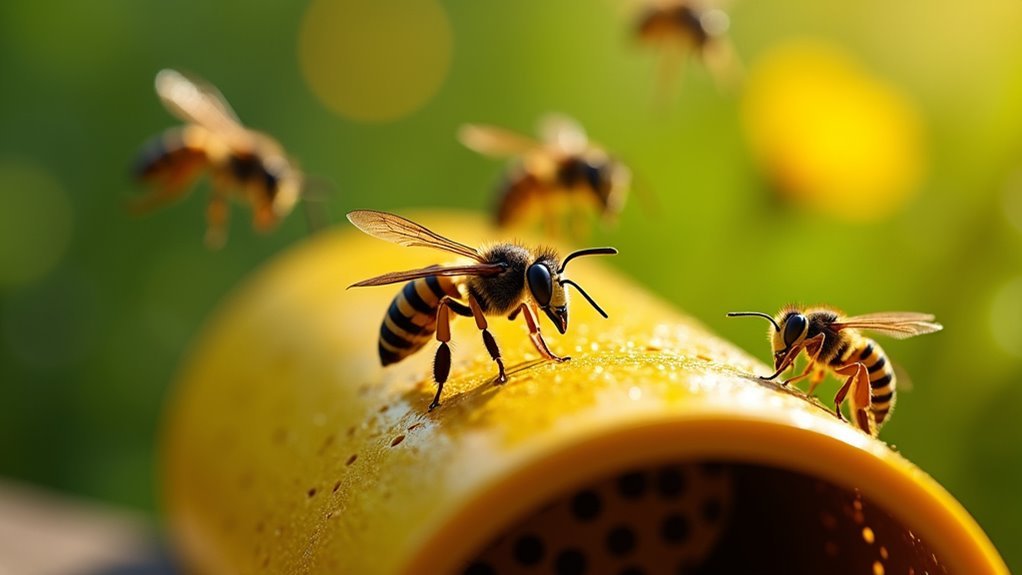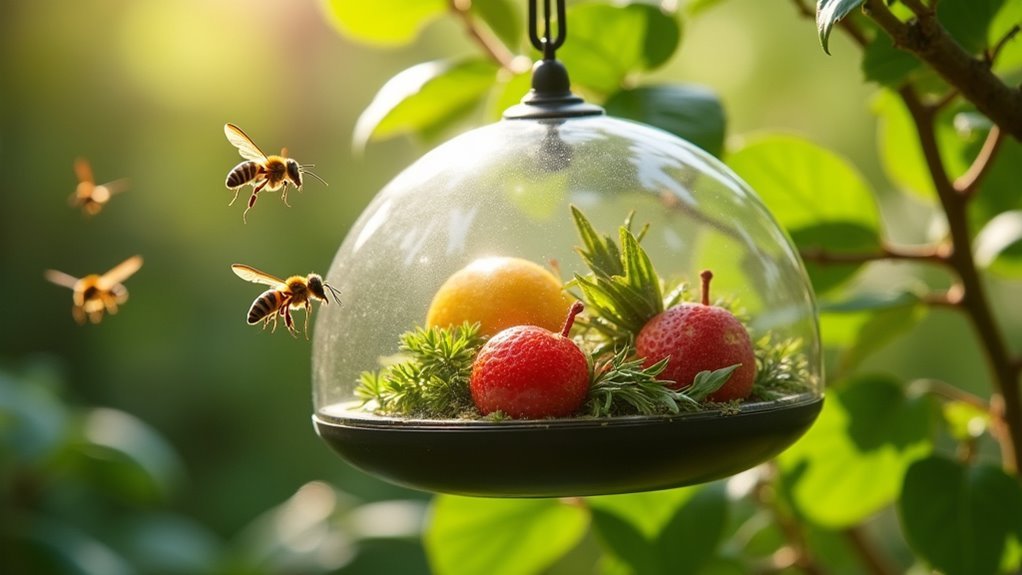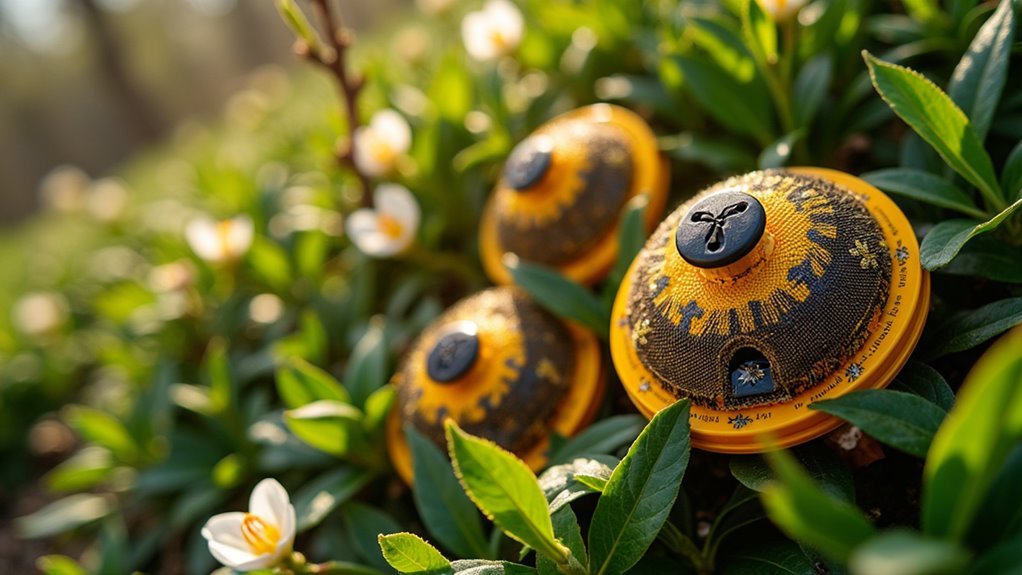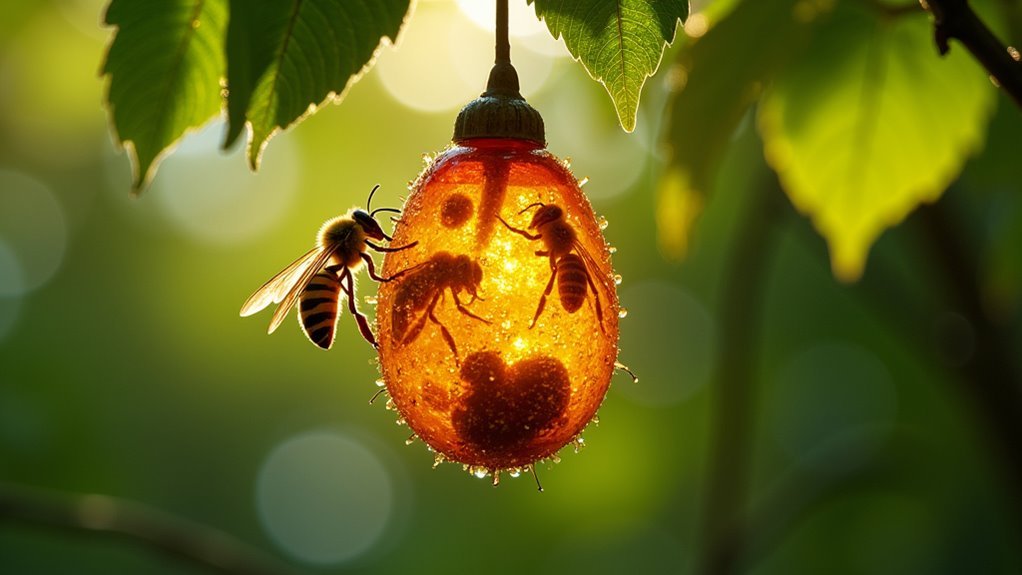Effective safe hornet traps work through strategic design combining multiple entry points with narrow openings and double-chambered construction that prevents escape. You’ll need non-toxic baits—protein-based options like lunch meat in spring for queens, and sugary substances in late summer. Place traps 20 feet from gathering areas, four feet high near natural settings. Commercial traps outperform DIY versions in durability and capture rates. Understanding proper seasonal timing and maintenance practices will maximize your hornet control success.
Understanding Hornet Behavior and Biology

Before you can effectively trap hornets, you’ll need to understand what drives their behavior and how their biology affects their activity patterns.
Hornets are highly social insects that establish colonies in trees, shrubs, and sheltered areas, with hundreds of individuals defending their nesting sites aggressively. They’ll sting multiple times using smooth, barbless stingers when threatened.
These insects feed primarily on other insects and sugary substances, making them valuable for natural pest control while simultaneously threatening your outdoor spaces.
Their life cycle progresses through egg, larva, pupa, and adult stages. The most effective trapping occurs in early spring when you can target queens before they establish new colonies.
European Hornets, reaching 1.5 inches with distinctive yellow-brown stripes, represent the largest species you’ll encounter.
Key Design Elements That Make Traps Work
While understanding hornet behavior provides the foundation for successful trapping, you’ll achieve the best results when your trap incorporates specific design elements that exploit their natural instincts.
The most highly effective traps feature multiple entry points with a narrow opening design that allows hornets to enter easily but prevents escape.
You’ll want a double-chambered construction that creates an additional barrier once insects enter the initial compartment.
- Strategic Entry Design: Multiple wide entrances funnel hornets through a narrow opening into the capture chamber
- Escape Prevention: Double-chambered systems guarantee trapped hornets can’t find their way back to exit points
- Durable Construction: Weather-resistant materials like ABS plastic maintain trap integrity across seasons
This engineered approach maximizes your trap to capture rates while guaranteeing long-term reliability.
Non-Toxic Bait Options for Maximum Attraction

Creating effective bait requires matching your ingredients to hornets’ seasonal dietary preferences.
In spring, you’ll want protein-based non-toxic bait options like lunch meat or hamburger to attract wasps and hornets seeking nutrition for their developing colonies.
During late summer and early fall, switch to sugary substances such as sugar water, fruit juice, or jam when hornets crave carbohydrates.
Avoid using honey since it attracts beneficial bees rather than your intended targets. Instead, add a small amount of vinegar to your bait mixture – this deters bees while still appealing to hornets.
Incorporate Dawn dish soap into your bait to prevent captured wasps from escaping once they enter the trap.
Remember to refresh your bait weekly for continued effectiveness throughout the season.
Strategic Placement for Optimal Results
Once you’ve prepared your non-toxic bait, proper trap placement becomes the determining factor in your success rate.
Strategic placement requires positioning traps at least 20 feet from outdoor activity areas where people gather. You’ll want to place them near natural settings like bushes and trees where hornets typically nest and forage.
Position traps at least 20 feet from gathering areas, near bushes and trees where hornets naturally nest and forage.
Mount traps approximately four feet above ground and at least 10 yards from high-traffic zones. This height maximizes visibility while minimizing human interaction.
Avoid positioning traps near existing yellowjacket nests, as this attracts wasps to areas where they’re already active.
Trapping Wasps Effectively:
- Use multiple traps around your property’s perimeter for wider coverage
- Position near natural foraging areas like vegetation and tree lines
- Maintain safe distances from both human activity and existing nests
Seasonal Timing and Trap Effectiveness

You’ll maximize your trap’s effectiveness by aligning your bait strategy with seasonal wasp behavior patterns.
Start with protein-based baits in spring to attract queens seeking food sources, then switch to sugar-based baits during summer when worker populations peak.
Fall represents your final opportunity to target the highest activity levels before colonies naturally decline for winter.
Spring Protein Bait Strategy
Two critical factors determine your spring hornet trapping success: timing your protein bait deployment and understanding seasonal foraging behavior.
During early spring, hornets actively hunt for protein sources to nourish their developing larvae, making lunch meat and hamburger incredibly effective in homemade wasp traps. This spring protein bait strategy targets both worker hornets and queens before they establish problematic colonies.
You’ll capture considerably more wasps and hornets by setting protein-baited traps early, preventing population explosions later in the season.
Fresh bait replacement every few days maintains trap effectiveness, as hornets prefer new protein sources over decomposing alternatives.
- Target queens during early spring to prevent entire colony establishment
- Replace protein bait regularly to maintain maximum attractiveness and capture rates
- Switch to sugar-based baits in late summer when dietary preferences change
Summer Sugar Transition
As summer progresses and hornet colonies mature, their dietary preferences shift dramatically from protein-rich foods to sugar-based energy sources.
You’ll need to change from protein baits to sugar-based baits like sugar water or fruit juice to maintain trap effectiveness. This dietary shift occurs because hornets require energy-rich foods during late summer months.
Natural sugar attractants greatly increase your capture rates when aligned with hornets’ foraging behavior.
You should rebait traps weekly to guarantee continued effectiveness and prevent nest growth. Position traps near trees and shrubs where hornets commonly forage.
The change to sugar-based baits is vital for successful trapping during summer.
Without this adjustment, your traps won’t attract hornets effectively, allowing colonies to expand unchecked in your area.
Fall Peak Activity
When fall arrives, hornet colonies reach their peak size and activity levels, creating the most challenging yet effective trapping opportunities of the year.
During this fall peak activity period, hornets become increasingly aggressive while foraging for food to prepare for winter survival. You’ll find that sugar-based attractants work exceptionally well during this time, as colonies desperately search for energy-rich substances.
Position your effective traps near bushes and trees where hornets naturally nest and forage. Choose hornet-specific traps with multiple entry points and specialized lures for maximum capture rates.
- Strategic placement: Target natural environments where hornets actively hunt for food sources
- Enhanced baiting: Refresh sugar-based attractants frequently to maintain peak effectiveness
- Aggressive maintenance: Monitor and re-bait traps regularly during heightened seasonal activity
DIY Vs Commercial Trap Comparison
When choosing between DIY and commercial hornet traps, you’ll need to weigh cost savings against proven performance.
Your decision should consider how much you’re willing to spend on materials versus investing in a durable, tested solution.
You’ll also want to think about whether you prefer customizing your own setup or having a ready-to-use trap that’s easier to maintain.
Cost and Materials
Budget considerations play an essential role when deciding between DIY and commercial hornet traps. You’ll find DIY traps incredibly cost-effective, requiring only common materials like plastic soda bottles at minimal expense.
Commercial traps typically cost $10 to $30 per pack, making them considerably more expensive upfront.
However, material quality differs substantially between options. Commercial traps feature durable ABS plastic that’s weather-resistant and built for outdoor conditions.
Your DIY traps won’t match this longevity or effectiveness in harsh weather.
- DIY traps offer immediate savings but may require frequent replacements due to inferior materials
- Commercial traps provide better long-term value through reusable, low-maintenance designs
- Material costs vary considerably – homemade solutions use household items while commercial options require specialized manufacturing
Effectiveness and Durability
Performance differences between DIY and commercial hornet traps become apparent when you examine their design features and longevity.
Commercial traps outperform homemade versions through multiple entry points and weather-resistant construction that maintains effectiveness across seasons. You’ll find specialized lures in commercial models attract broader wasp species compared to basic DIY baiting methods that vary inconsistently.
Durability sets commercial traps apart with double-chamber designs preventing escape while DIY plastic bottle traps often fail at containment.
You won’t need constant replacements since commercial traps offer reusable seasonal functionality, unlike disposable DIY versions that degrade quickly.
Customer feedback confirms commercial traps require less maintenance and monitoring, while homemade alternatives demand frequent adjustments to remain functional, making commercial options more reliable long-term investments.
Setup and Maintenance
Although commercial hornet traps like the Protecker Wasp Trap feature sophisticated double-chambered designs with multiple entry points, you’ll find their setup process straightforward compared to constructing DIY alternatives from plastic bottles.
Commercial traps require simple assembly and hanging at least 20 feet from human activity areas. You’ll empty and refill them with seasonal baits every few weeks – protein for spring, sugar for summer.
DIY traps demand more hands-on maintenance, requiring weekly checks for dead wasps and frequent rebaiting to maintain effectiveness.
- Strategic positioning: Place DIY traps away from food sources near wasp activity zones for peak capture rates
- Durability considerations: Commercial traps withstand outdoor conditions longer than homemade versions requiring regular replacement
- Maintenance frequency: DIY traps need weekly attention while commercial options operate effectively with bi-weekly servicing
Safety Features That Protect Beneficial Insects
When selecting a hornet trap, you’ll want to prioritize designs that protect beneficial insects like honeybees and pollinators.
Safe hornet traps feature non-toxic, natural bait formulations that specifically target wasps and hornets without attracting valuable pollinators. These traps incorporate escape-prevention mechanisms that capture only intended pests while allowing beneficial insects to remain unharmed.
Strategic placement away from flowering plants and bee habitats further minimizes unintentional capture of helpful species.
The trap design focuses exclusively on hornet and wasp attraction patterns, avoiding broad-spectrum lures that could endanger the ecosystem.
You’ll find these traps eliminate the need for harmful insecticides that damage beneficial insects and their environments.
This targeted approach guarantees you’re protecting your property while preserving essential pollinators that support local plant life and agricultural systems.
Maintenance and Monitoring Best Practices
Once you’ve installed your safe hornet trap, establishing a consistent maintenance routine guarantees peak effectiveness while preserving the trap’s beneficial insect protection features.
You’ll need to check your traps weekly, removing dead wasps and cleaning with warm soapy water to eliminate residue that deters new captures. Refill and rebait weekly, switching from protein-based baits in spring to sugar-based options in summer for ideal attraction.
Monitor trap placement regularly, ensuring they remain 10 yards from high-activity areas and positioned four feet above ground. Additionally, inspect your traps for weather damage and structural wear that could compromise performance.
- Weekly monitoring prevents trap saturation – Full traps deter new hornets from entering
- Seasonal bait rotation maximizes effectiveness – Hornet dietary preferences change throughout the year
- Regular maintenance preserves selective features – Clean traps work better at targeting harmful species while protecting beneficial insects
Environmental Benefits of Chemical-Free Solutions
While conventional pest control methods flood your property with toxic chemicals, chemical-free hornet traps offer a sustainable alternative that protects both your family and the environment.
These solutions eliminate the risk of pesticide exposure to beneficial insects like bees and surrounding wildlife. You’ll prevent environmental contamination by avoiding toxic residues that leach into soil and waterways, promoting healthier ecosystems around your home.
Chemical-free hornet traps safeguard beneficial insects and prevent toxic contamination of soil and waterways, creating healthier ecosystems around your property.
Eco-friendly trapping methods specifically target hornets and wasps without disrupting broader insect populations or food chains.
The non-toxic materials used in these traps don’t contribute to plastic pollution, as many designs prioritize reuse and longevity.
Frequently Asked Questions
What Is the Best Bait for Hornet Traps?
You’ll want protein-rich baits like lunch meat in early spring when hornets build nests. Switch to sugary liquids during late summer and fall. Add vinegar to deter bees and dish soap to prevent escapes.
What Attracts Hornets to a Trap?
You’ll attract hornets using protein-based baits like meat in spring, then switching to sugary substances in fall. Strategic trap placement near trees and bushes, plus wasp-specific attractants, draws them effectively.
What Do Hornets Hate the Most?
You’ll find hornets hate strong scents like peppermint oil and vinegar most. They’re also repelled by high-frequency sounds from electronic devices and can’t stand clean, organized spaces without food sources.
Why Is the Wasp Trap Not Working?
You’re probably using wrong bait for the season, placed it too close to activity areas, or haven’t maintained it properly. Check bait type, trap location, and clean it weekly.
In Summary
You’ll achieve the best results by combining proper trap design with strategic placement and timing. Choose non-toxic baits that won’t harm beneficial insects, and you’ll protect your local ecosystem while controlling hornets effectively. Remember to monitor your traps regularly and adjust placement based on seasonal patterns. By selecting the right features and maintaining consistent oversight, you’ll create a safe, chemical-free solution that’s both environmentally responsible and highly effective.





Leave a Reply